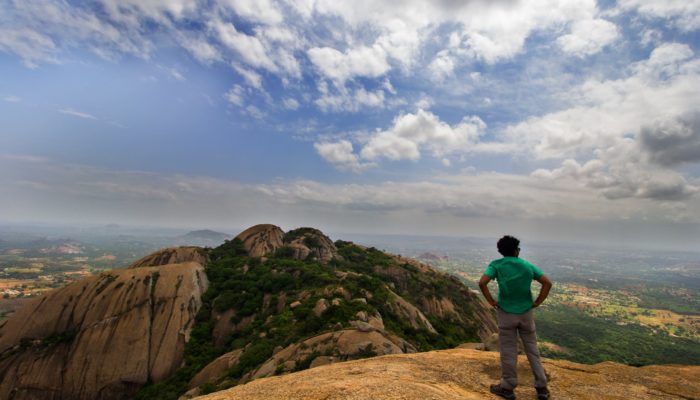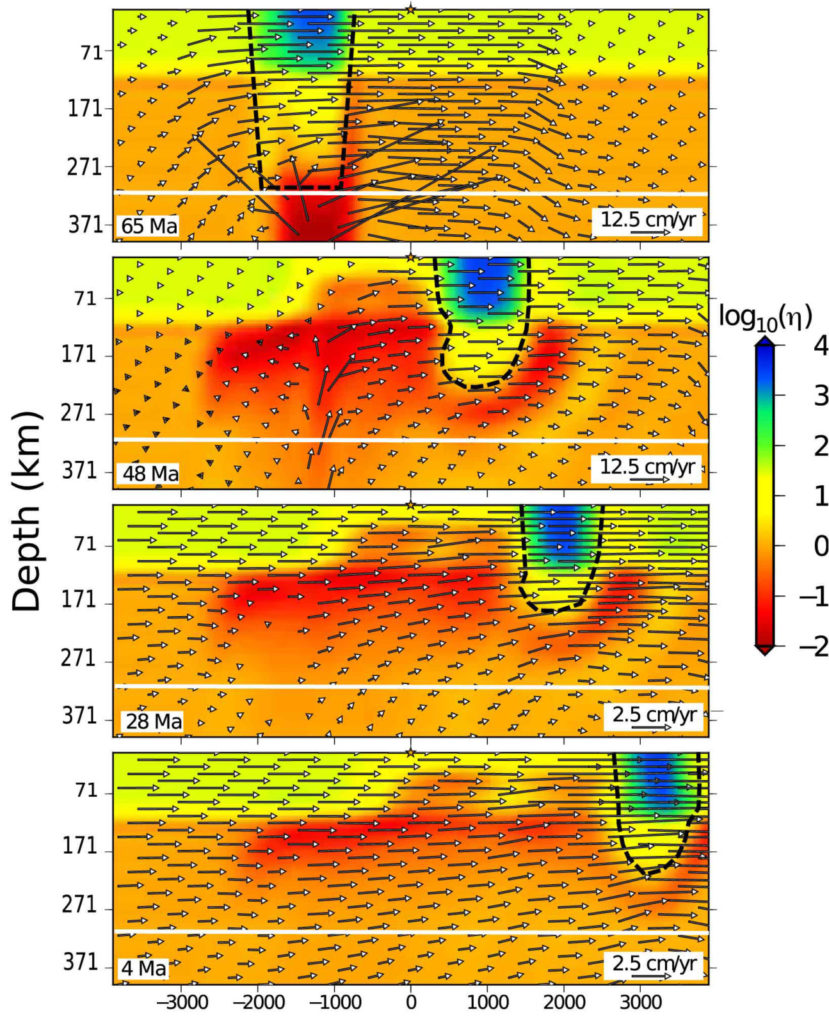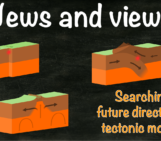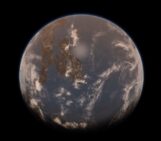
Plume craton interaction is a fascinating geological phenomenon. The Indian plate, which has experienced several plume eruptions underneath it, is one of the best locations to study the effect of plume craton interaction. In this week’s news and view, I will provide an overview of the controversy and hypotheses related to the plume craton interaction within the Indian plate since the mid-Cretaceous. For more details, check our recent article “Could the Réunion plume have thinned the Indian craton?“
The Indian continental plate was a part of Gondwanaland (Fig. 1). It broke away from Antarctica, Australia and Africa during the supercontinental break-up. Since then, the Indian lithosphere has experienced several mantle plume eruptions underneath it. Geological evidence of the Panjal trap at ~280 Ma is probably the oldest large igneous province within the Indian plate. At ~120-117 Ma, one small pulse of the Kerguelen plume probably created the Rajmahal trap. This eruption could have affected the eastern Indian craton’s root. Later, Kerguelen erupted in large volume and formed the gigantic Kerguelen plateau at ~100 -95 Ma. But most of this eruption took place within the oceanic lithosphere leaving the Indian continental lithosphere unaffected. Marion plume erupted ~90 Ma, which was very close to the southern Indian craton and could have started affecting the dynamics of the Indian plate. Finally, the Réunion plume erupted ~65Ma directly underneath the Southern Indian craton, significantly influencing the plate motion, lithosphere thickness, and the complete geodynamic scenario of the India- Eurasia collision.

Figure 1: Location of different tectonic plates, large igneous provinces, hotspots and Indian cratons at 90 Ma and 65 Ma.
One of the major geological events that took place in this time is the sudden increase of Indian plate velocity. At ~65 Ma, Indian plate velocity increased up to ~20 cm/year, which is unusually higher than other plate motions. Cande and Stegman (2011) proposed that the eruption of the Réunion plume pushed the Indian plate to achieve this higher velocity. Though the plume push force could have been a significant factor for plate acceleration, it might not be sufficient to sustain the higher velocity of the Indian plate for ~20 million years. Jagoutz et al. (2015) proposed that a double subduction zone could be another efficient way to achieve and sustain this higher velocity. Pusok and Stegman (2020) showed that the combination of both plume push and double subduction pull could maintain a higher velocity of the Indian plate for a prolonged period.

Figure 2: Cross-section showing thinning of the Indian craton due to Réunion plume eruption. The lithosphere-asthenosphere boundary is becoming week due to plume material. (Figure published in the supplementary section of Paul and Ghosh (2022), https://doi.org/10.1130/GEOL.S.16985356.v1
Apart from these tectonic explanations, other rheological and structural controls might have also contributed to the acceleration and further sustain of the Indian plate velocity. Kumar et al. (2007) proposed that the eruption of the Réunion plume might have thinned the Indian craton. A thinner lithosphere could easily slide at a faster speed above the convecting mantle. However, there is a great debate on the thickness of the Indian craton. In the last three and half decades, several studies have estimated the thickness of the Indian craton, varying from 78 to 300 km (cf. Paul and Ghosh, 2022). Probably because of the smaller size of the craton or due to the lack of dense seismic networks in this region, a reasonable estimate of craton thickness is severely lacking. Recently, Paul and Ghosh (2022) have studied the nature of plume craton interaction and quantified if the plume eruption in this geological setting could affect the craton thickness. Their study showed that the Indian craton could possibly thin due to thermomechanical erosion aided by the mantle plume and convective shearing (Davies 1994). This study developed different models with varying craton, asthenosphere, and plume viscosity and found that a maximum of 43% cratonic root can be destroyed in 65 million years of evolution (Fig. 2). This thinning of the cratonic root was rather gradual than an instantaneous effect of plume eruption at 65 Ma. So, thinning of the Indian craton may have a very insignificant control on the Indian plate velocity. On the other hand, van Hinsbergen et al. (2011) briefly pointed out the lithosphere-asthenosphere boundary could be lubricated due to the mantle plume eruption, which can also be a potential reason for the long term higher velocity of the Indian plate. Paul and Ghosh (2022) agreed with the previous conclusion and showed that such lubrication is highly possible as the plume material was dragged along the Indian plate.
The long-term sustained velocity of the Indian plate finally diminished after the collision with the Eurasian plate. The impact created the world’s highest mountain chain – the Himalayas, which has controlled the climate, topography, and the overall human history of the Indian subcontinent.
References: Cande, S.C. and Stegman, D.R., 2011. Indian and African plate motions driven by the push force of the Reunion plume head. Nature, 475(7354), pp.47-52. Davies, G.F., 1994. Thermomechanical erosion of the lithosphere by mantle plumes. Journal of Geophysical Research: Solid Earth, 99(B8), pp.15709-15722. Jagoutz, O., Royden, L., Holt, A.F. and Becker, T.W., 2015. Anomalously fast convergence of India and Eurasia caused by double subduction. Nature Geoscience, 8(6), pp.475-478. Kumar, P., Yuan, X., Kumar, M.R., Kind, R., Li, X. and Chadha, R.K., 2007. The rapid drift of the Indian tectonic plate. Nature, 449(7164), pp.894-897. Paul, J. and Ghosh, A., 2022. Could the Réunion plume have thinned the Indian craton?. Geology, 50(3), pp.346-350. Pusok, A.E. and Stegman, D.R., 2020. The convergence history of India-Eurasia records multiple subduction dynamics processes. Science advances, 6(19), p.eaaz8681. van Hinsbergen, D.J., Steinberger, B., Doubrovine, P.V. and Gassmöller, R., 2011. Acceleration and deceleration of India‐Asia convergence since the Cretaceous: Roles of mantle plumes and continental collision. Journal of Geophysical Research: Solid Earth, 116(B6).




